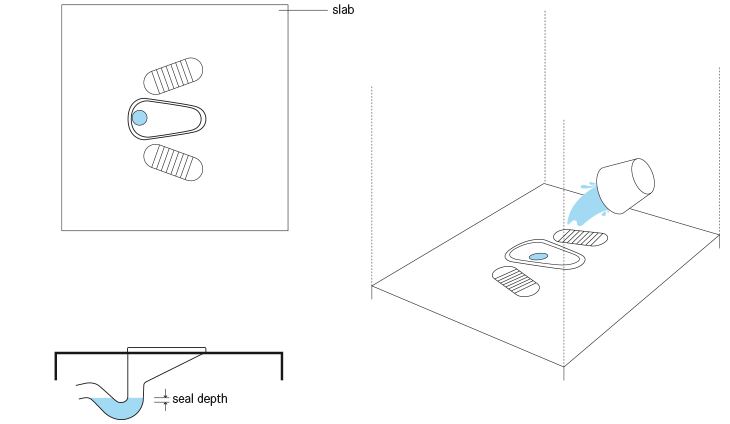
A pour flush toilet is like a regular cistern flush toilet except that the water is poured in by the user, instead of coming from the cistern above. When the water supply is not continuous, any cistern flush toilet can become a pour flush toilet.
| In | Out |
|---|---|
Urine, Faeces, Freshwater, Dry Cleansing Materials, |
Blackwater, Faecal Sludge |
Just like a cistern flush toilet, the pour flush toilet has a water seal that prevents odours and flies from coming back up the pipe. Water is poured into the bowl to flush the toilet of excreta; approximately 2 to 3 L is usually sufficient. The quantity of water and the force of the water (pouring from a height often helps) must be sufficient to move the excreta up and over the curved water seal.
Both pedestals and squatting pans can be used in the pour flush mode. Due to demand, local manufacturers have become increasingly efficient at mass-producing affordable pour flush toilets and pans.
The water seal at the bottom of the pour flush toilet or pan should have a slope of at least 25°. Water seals should be made out of plastic or ceramic to prevent clogs and to make cleaning easier (concrete may clog more easily if it is rough or textured). The S-shape of the water seal determines how much water is needed for flushing. The optimal depth of the water seal head is approximately 2 cm to minimize the water required to flush the excreta. The trap should be approximately 7 cm in diameter.
The pour flush toilet (or squatting pan) prevents users from seeing or smelling the excreta of previous users. Thus, it is generally well accepted. Provided that the water seal is working well, there should be almost no odours and the toilet should be clean and comfortable to use.
Because there are no mechanical parts, pour flush toilets are quite robust and rarely require repair. Despite the fact that it is a water-based toilet, it should be cleaned regularly to maintain hygiene and prevent the buildup of stains. To reduce water requirements for flushing and to prevent clogging, it is recommended that dry cleansing materials and products used for menstrual hygiene be collected separately and not flushed down the toilet.
The water seal is effective at preventing odours and it is appropriate for those who sit or squat (pedestal or slab) as well as those who cleanse with water. It is only appropriate when there is a constant supply of water available. The pour-flush toilet requires (much) less water than a traditional cistern flush toilet. However, because a smaller amount of water is used, the pour-flush toilet may clog more easily and thus, require more maintenance.
If water is available, this type of toilet is appropriate for both public and private applications. Pour-flush toilets are adequate for almost all climates.
The Design of Pour-Flush Latrines
The technical note was produced as a joint United Nations Development Programme and World Bank contribution to the International Drinking Water Supply and Sanitation Decade. It sets out guidelines for the design of pour-flush latrines, based upon TAG's (Technology Advisory Group) experience in India, Brazil and elsewhere. These guidelines have been written especially for use in developing countries. Consequently, emphasis has been placed on achieving simplicity of design consistent with reliability of operation.
MARA, D.D. (1985): The Design of Pour-Flush Latrines. (= TAG Technical Note No. 15 ). United Nations Development Programme (UNDP) and World Bank URL [Accessed: 02.08.2010]Low-cost Urban Sanitation
This book covers the public health, technical, socioeconomic, sociocultural and institutional aspects of sanitation in towns and cities of developing countries. The text features excreta-related diseases and the use of sanitation to reduce their transmission. The sanitation technologies covered in detail are VIP latrines, pour-flush toilets, septic tanks, settled sewerage and simplified sewerage, with additional chapters on sullage disposal, pit emptying, and sewage treatment and reuse. Sociocultural constraints on sanitation systems and their socioeconomic costing are described, together with hygiene education, which is essential in order to achieve maximum benefits to health. The text also explains how to choose the most appropriate sanitation option for a given low-income community. Finally, institutional aspects are reviewed, including effective sanitation programme planning, monitoring and evaluation.
MARA, D. (1996): Low-cost Urban Sanitation. United Kingdom: WileyManual on the design, construction and maintenance of low-cost pour-flush water seal latrines in India
This manual has been prepared for agencies, contractors and individuals involved in various aspects of the low-cost pour-flush water seal latrine programme in India. The inherent principles are, however, of general application; with minor modifications, the technical details can be readily adapted to meet the needs of different areas, particularly where water is used for anal cleansing. The manual presents salient features in regards to design, construction and maintenance as well as the administration of low-cost pour-flush water seal latrines with offset twin pits. It contains extensive drawings, tables of quantities for construction materials used for different designs as well as standard forms for by-laws and for general information on project administration and supervision.
ROY, A.K. CHATTERJEE, P.K. GUPTA, K.N. KHARE, S.T. RAU, B.B. SINGH, R.S. (1984): Manual on the design, construction and maintenance of low-cost pour-flush water seal latrines in India. (= TAG technical note; no. 10 ). United Nations Development Programme (UNDP) and World Bank URL [Accessed: 01.06.2010]
